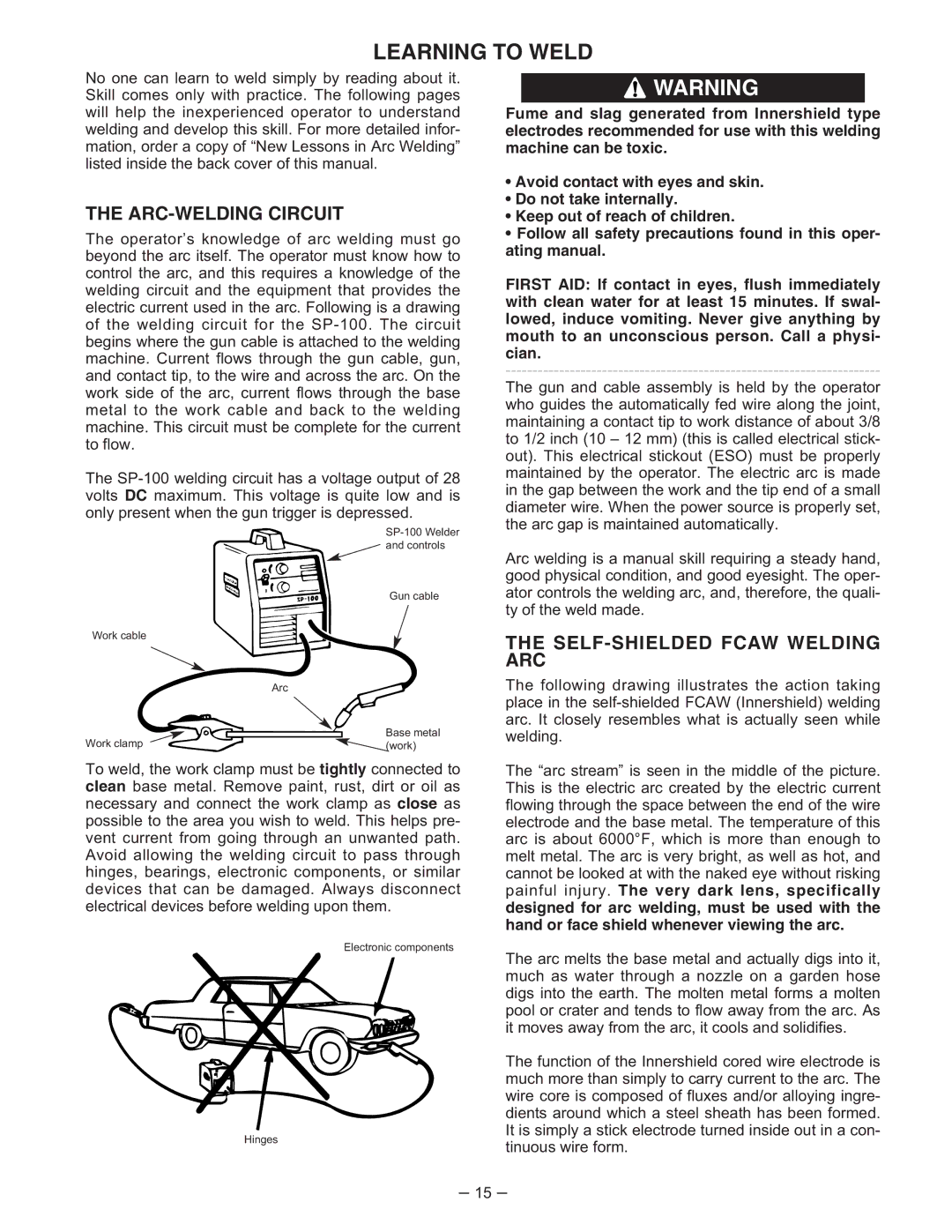
LEARNING TO WELD
No one can learn to weld simply by reading about it. Skill comes only with practice. The following pages will help the inexperienced operator to understand welding and develop this skill. For more detailed infor- mation, order a copy of “New Lessons in Arc Welding” listed inside the back cover of this manual.
THE ARC-WELDING CIRCUIT
The operator’s knowledge of arc welding must go beyond the arc itself. The operator must know how to control the arc, and this requires a knowledge of the welding circuit and the equipment that provides the electric current used in the arc. Following is a drawing of the welding circuit for the
The
![]() and controls
and controls
Gun cable
Work cable
![]() WARNING
WARNING
Fume and slag generated from Innershield type electrodes recommended for use with this welding machine can be toxic.
•Avoid contact with eyes and skin.
•Do not take internally.
•Keep out of reach of children.
•Follow all safety precautions found in this oper- ating manual.
FIRST AID: If contact in eyes, flush immediately with clean water for at least 15 minutes. If swal- lowed, induce vomiting. Never give anything by mouth to an unconscious person. Call a physi- cian.
The gun and cable assembly is held by the operator who guides the automatically fed wire along the joint, maintaining a contact tip to work distance of about 3/8 to 1/2 inch (10 – 12 mm) (this is called electrical stick- out). This electrical stickout (ESO) must be properly maintained by the operator. The electric arc is made in the gap between the work and the tip end of a small diameter wire. When the power source is properly set, the arc gap is maintained automatically.
Arc welding is a manual skill requiring a steady hand, good physical condition, and good eyesight. The oper- ator controls the welding arc, and, therefore, the quali- ty of the weld made.
THE SELF-SHIELDED FCAW WELDING ARC
| Arc |
Work clamp | Base metal |
(work) |
To weld, the work clamp must be tightly connected to clean base metal. Remove paint, rust, dirt or oil as necessary and connect the work clamp as close as possible to the area you wish to weld. This helps pre- vent current from going through an unwanted path. Avoid allowing the welding circuit to pass through hinges, bearings, electronic components, or similar devices that can be damaged. Always disconnect electrical devices before welding upon them.
The following drawing illustrates the action taking place in the
The “arc stream” is seen in the middle of the picture. This is the electric arc created by the electric current flowing through the space between the end of the wire electrode and the base metal. The temperature of this arc is about 6000°F, which is more than enough to melt metal. The arc is very bright, as well as hot, and cannot be looked at with the naked eye without risking painful injury. The very dark lens, specifically designed for arc welding, must be used with the hand or face shield whenever viewing the arc.
Electronic components
Hinges
The arc melts the base metal and actually digs into it, much as water through a nozzle on a garden hose digs into the earth. The molten metal forms a molten pool or crater and tends to flow away from the arc. As it moves away from the arc, it cools and solidifies.
The function of the Innershield cored wire electrode is much more than simply to carry current to the arc. The wire core is composed of fluxes and/or alloying ingre- dients around which a steel sheath has been formed. It is simply a stick electrode turned inside out in a con- tinuous wire form.
– 15 –
